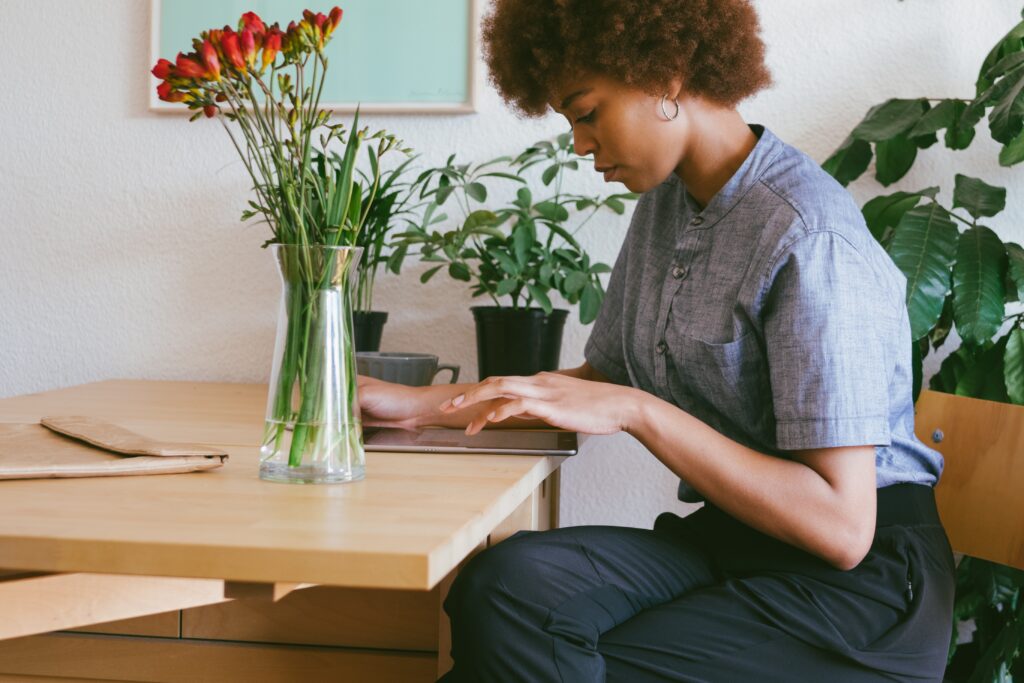
28 Sep 8 Work from Home Tips You’ll Want to Know
2022 is a year full of surprises. After the pandemic swept throughout the world, companies did what they had to in order to survive. For most, it meant allowing their workers to work from home. Now that Covid-19 has gotten under control (at least somewhat), many workers expected their companies to force them back into the office.
But they didn’t. In fact, many companies adapted to their employees working from home. They stopped paying for large office spaces—instead renting a space that workers could come and go from if they pleased—and they spent more time investing in out-of-work bonding events to bring everyone together. It created a whole different environment for employees and their employers. It also allowed companies to expand past the borders of cities they resided in, growing more than previously thought possible.
Still new to the whole work-from-home situation and aren’t sure how to make things easier for yourself? Check out these eight work-from-home tips to get you on the right path!
Jobs in 2022 – The Influx of Work-from-Home Jobs
More than ever, 2022 has shown that the job market is as different as it has ever been. We aren’t expected to reside in the same city/state as the jobs we apply to anymore. This even goes for those of us that are up for relocating. Now you can find jobs from nearly any state and apply (as long as your requirements match, of course).
What are the main differences between in-office, work-from-home, and hybrid jobs?
In-Office Jobs
Though not every job requires you to work from the office, some companies give you the choice to. And if you’re one of those people that fare better in an environment dedicated solely to work, it might be better for you to take that trip to the office every day.
It can be beneficial to work from the office still if you often have to meet with co-workers outside of a Zoom call or if you get easily distracted by the things around your house. The biggest difference in 2022 might be the number of people still in the office or the way certain things are conducted.
Work-from-Home Jobs
Quite opposite to in-office jobs, work-from-home jobs have a bit more freedom to them. Not only do you not have to travel to work every day, but you have the ability to be a bit more in control of your schedule (within certain parameters, of course).
Work-from-home opportunities can also help remove the distractions present at the office—including talking with co-workers, walking to and from various locations in the office (like the break room, meeting rooms, bathroom, etc.), and a few others.
Hybrid Jobs
Though working from home has become quite popular in 2022, not everyone is that excited about it. To give employees a chance to choose their working environment, employers have begun implementing a hybrid work environment. This allows the employee to work from home and work in the office.
This option gives you the ability to get those in-person meetings out of the way while also allowing you the comfort of staying home when you’re not needed in person. Because, even if we like to think we are, we aren’t always needed in the office. It saves us time (and energy) to stay home and work.
How to Make the Most of Working from Home:
If you’re trying out this work-from-home thing for the first time, you might be at a bit of a loss on how to balance things the right way. Though you might be getting your work done, you could be having a hard time feeling satisfied with the quality of your work or you could be feeling a bit uncoordinated.
If your work-from-home experience is a bit more chaotic than you expected, don’t worry! You have to set your own rhythm still. For now, check out these eight tips to get yourself on the right track to working from home.
1. Set Your Own Schedule to Work from Home
This one seems a bit obvious, but you’ll need to set your own schedule if you want to make the most of your workday.
However, this goes a bit further than setting what time you start and what time you end. This could mean breaking down your day hour-by-hour or blocking off the beginning of your workday versus the last couple of hours. It depends on how you work best.
Personally, I utilize a day-by-day schedule that’s broken down into half-hour blocks. Some responsibilities don’t require the full half an hour to complete, but I find it easier and less stressful to give each responsibility at least thirty minutes to complete. For bigger responsibilities, I block off an hour or more for them.
By detailing your daily schedule, it can help you organize your days and allow you the freedom to adjust. It also feels pretty good when you can cross off one completed thing often on your to-do list. Breaking it down this way can also make your workday seem less daunting in scale and less stressful.
2. Limit Distractions…
Though there are some distraction-free parts of working from home, there are different kinds of distractions you’ll have to be careful of.
In the office, there’s not usually a TV full of movies, videos, and other stream-related apps to keep your mind thoroughly distracted. While you might have a TV in the office, you won’t have control over it as you do at home. This is the same for your phone. In the office, it’s easy to keep away from it when the possibility of your boss catching you is higher. It’s not so easy to keep your hands off of the device when you’re working from home, a place you’re used to being on it.
If you’re having a hard time keeping yourself from giving in to these distractions, try adjusting your environment. Perhaps set up your home office in a room without a TV. If that isn’t possible, you could try unplugging the TV or simply hiding the remote in another room. You can do the same with your phone; you can simply lock your phone away in a drawer somewhere or keep it out of reach.
The more often you do this, the easier it will be to keep from giving in to distractions. And before you know it, you won’t need to keep yourself under surveillance that extremely.
3. … But Allow Breaks
Though we just explained why you shouldn’t be getting distracted throughout the workday, working from home is tough if you’re only in work mode for eight-plus hours straight. In the office, you can get minimal breaks between responsibilities by talking with co-workers, going to make a cup of coffee, walking between locations, etc. You won’t get those kinds of breaks while working from home.
You need to find a healthy balance between working and taking breaks so you don’t suffer from burnout. After finishing major responsibilities, reward yourself with a short ten or fifteen-minute break to stretch or make yourself another cup of coffee. Take a few minutes to pet your dog/cat (or whichever pet you have keeping you company at home) or take them for a short walk outside to get some fresh air.
Being cooped up inside all day is draining, especially if you are only working. So, allow yourself a few minutes here and there throughout the day to give your brain a break.
4. Figure Out What Works Best for You
Again, this one might be a bit obvious but it is necessary to reiterate. Make sure you’re creating a system that works best for you.
You could read through a thousand different blogs about working from home and construct the “perfect” work-from-home schedule based on what others do. However, it won’t mean much if it doesn’t work for you. Everyone has their own necessities and best-fit solutions to getting through work. While something works for someone else, it might not work for you.
For instance, someone might need complete silence to get through their responsibilities with little distraction. For others, they could need music playing in the background or a constant buzz of people talking.
It’s all about finding what works best for you while you work from home. So, try a few different things and see what feels the most comfortable.
5. Keep Contact with Your Co-Workers
Working from home is actually far more isolating than you realize. While it can limit distractions of co-workers around the office, it also cuts off communications quite a bit.
Make sure to reach out to your co-workers once in a while. Perhaps not even for work purposes. It’s always a good idea to have those lines of communication open. This way, if something work-related does come up, you can bounce ideas off of someone else at your workplace.
If you have the chance to, try to participate in those company events your employers are putting on. These are designed to help keep connections open between employees and leave no one feeling isolated.
6. Dress to Impress (or, at least, to look presentable)
One of the biggest misconceptions of work-from-home jobs is that you can simply roll out of bed and clock in while still in your pajamas. While you can do that, it’s not always the best thing for your work mentality.
Though you can spend a few days here and there rocking your sweatpants and stained t-shirts to work, it won’t help get you in the right mindset. If you attribute work to your “lazy” outfit, then you start blending the work and life balance.
By dressing up in clothes you’d usually go to work in, you create a distinct line between what’s work and what’s life. This alone can help your brain get into work mode.
7. Set Up Your Own Work-from-Home Office Space!
Similarly to your clothing, it’s always a good idea to have a specific space dedicated to work.
More than ever, your work and life balance needs to be strictly defined when you work from home. If you clock into work while in a spot you’re too comfortable with, you might fall into a familiar rhythm of not working or not relaxing.
By dedicating a specific area to work—this could be as simple as a specific seat at your dining table or as complex as an entire room—you can help create the divide between work and life more obvious, making it that much easier to get your work done throughout the day.
8. Set a Clear Line between “Life” Time and “Work” Time – Stick to It, No Matter What
We’ve already mentioned this a few times, but we will give it its own point to make sure you understand just how important it is to have a work and life balance.
Another issue that arises while working from home is the blurred definition of work and life balance. It’s harder to define when you leave work and begin life again. Sure, you can clock out for the day and leave your dedicated workstation. But isn’t it tempting to check your work email after a few hours to see if someone finally got back to you? Or what about those moments you suddenly get inspiration to finish that big project you’ve been working on? It’s especially tempting to fall back into work if you have notifications on your phone for your work accounts.
Make sure you set a clear line between when you’re working and when you’re relaxing at home. And be sure to stick to it, especially once you’re in “life” mode. Sometimes you can’t help going back into work mode—whether it’s because a deadline is nearing or something similar—but you need to make a valiant effort to treat working from home as you would going to a physical office. Once you’ve clocked out for the day, don’t try to think about anything work-related until you clock back in the next day.
Want to Find a Work-from-Home Job?
If you’re interested in working from home but haven’t found any luck in securing an interview, you might need to revamp your resume to adhere to the work-from-home concept. Or perhaps you need a few pointers on which work-from-home jobs would fit best for your specific career.
If so, check out the Career Services we offer at The Jonus Group. From mock interviews, resume revamps, and LinkedIn updates to career coaching sessions and job search assistance, our Career Services team can help get you on the right path.
Let’s set up a time to talk!









